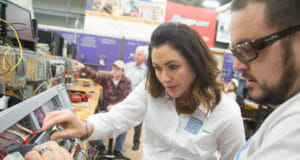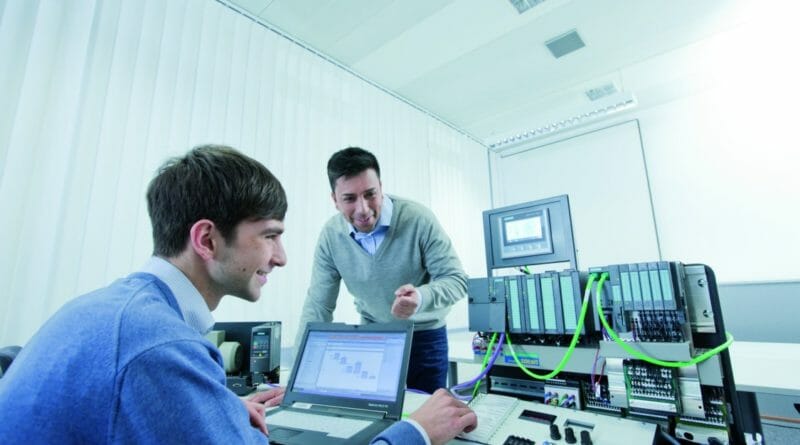Students Want Hands-on Learning
Article and interview from Fortune Magazine.
Within the next decade, more than 2 million openings for advanced manufacturing jobs in the U.S. could go unfilled, according to a 2021 study by Deloitte and The Manufacturing Institute. The issue? Filling entry-level manufacturing positions is challenging, plus the rapid pace of digital transformation in the industry, the study notes.
Companies aren’t just having trouble filling lower-paying, lower-level manufacturing roles. And pay can’t be to blame. Even entry-level advanced manufacturing jobs can clock in at six figures regardless of education levels. But Siemens, a global energy giant, is working with secondary, postsecondary, and graduate schools on developing these in-demand skills.
“Whether it’s computer science or software engineering or any of those things—smart manufacturing—and a lot of this software-based work that we’re seeing is really preparing students for getting high, high, high dollar amounts,” Amanda Beaton, U.S. program manager of Siemens Cooperates with Education, tells Fortune. “And the demand is growing exponentially.”
Students Want Hands-on Learning
To get ahead of the supply issue, global Fortune 500 energy company Siemens works with educational institutions to provide more hands-on training for students interested in pursuing a career in advanced manufacturing
After seeing success in Europe, Siemens Cooperates with Education was brought to the U.S. about a decade ago so that students can learn more about the company’s products and gain more experience with higher-end software, hardware, and manufacturing technologies. Siemens pairs with the whole gamut of educational institutions: middle schools, high schools, universities, graduate schools, adult learning career centers, union training centers, and everything in between. By and large, however, Siemens works with computer science, engineering, and mechatronics undergraduate and graduate programs at colleges and universities. Through paid partnerships, Siemens provides real-world manufacturing hardware and tools for students to use in the classroom. This allows for experiential learning with advanced manufacturing tools that students wouldn’t otherwise have access to until after graduation.
Learning Systems
SCE isn’t a pipeline program specifically for hire at Siemens; rather, this business line sells training packages, textbooks, and learning systems for use in the classroom to teach industry software and hardware. The company holds educator workshops across the U.S. for teachers and professors so they may get exposed to the technology before instructing their own classes.
“They can bring that back to students and talk about artificial intelligence and robots—all these different machine learning types of topics because they’ve spent three days in a Siemens facility learning and doing things hands on,” Beaton says.
Fortune sat down with Amanda Beaton to find out why more higher education institutions should implement more hands-on learning for future advanced manufacturing workers. The following interview has been edited for brevity and clarity.
Fortune: What does the demand look like for high-tech manufacturing jobs?
Beaton: There was already a reassuring trend before the pandemic where companies were looking to bring more manufacturing back to the U.S.—more flexible manufacturing and smarter, more automated manufacturing. They were looking at training people and educating people on these types of topics, and then the pandemic hit. This shined a light on the need for having more local manufacturing and the ability to produce things and have flexible manufacturing closer to home. That really grew a lot of demand.
Every school that I talk to can’t have enough students going through their programs and have enough graduates—whether it’s a two-year program, a four-year engineering program. There are certain accelerated programs that I’ve seen that are very focused on, say, artificial intelligence, or robotics.
How does the Siemens program combat that?
Demand has exploded. There are lots of smart manufacturing in what we call Industry 4.0-related jobs out there. Students can take their pick, and it’s almost frustrating because they get into bidding wars for salaries—outrageous starting stories—and it’s crazy, but it’s good for students.
Every instructor I talked to has placement rates of like 100% recently of the students graduating and getting jobs. And I didn’t see that five or eight years ago. I saw students kind of dabbling around getting graduate degrees or taking other paths or taking other jobs that weren’t necessarily in their field. Whether it’s computer science or software engineering or any of those things—smart manufacturing—and a lot of this software based work that we’re seeing is really preparing students for getting high, high, high dollar amounts. And the demand is growing exponentially.
How universities can improve their training
What can universities do to keep up with demand in the field?
I see schools giving students the ability to take online classes, but also physically come into labs and have access to work on projects where they can build things, and test, and do things with teams of people. There is this opportunity to take online classes, but also have access to hands-on experiential tools, hardware, and software.
I think it’s also useful for students to have a blend of professors and instructors. There are lots of instructors that, of course, have Ph.D.s and have done lots and lots of research around manufacturing, production, math, science, computer science, artificial intelligence—any of these things—and they’re global leading researchers in AI. But students should also have exposure to instructors who maybe worked at an automotive plant for 30 years, and now they’re teaching from a real experiential background.
I think that just works well for students because they get to see and ask questions from different types of classes and different types of instructors. Students now are demanding a lot of flexibility and they want to see a lot of cool products and work in teams to accomplish real-world problems. That’s where we do our best work: Where students really want to work with real products, real technologies and solve real industrial problems.
What advice do you have for someone wanting to get into the industry?
I think students should challenge themselves and tackle hard projects and learn how to overcome failure. In any case, whether it’s in high school or college, students should try to get experience with an internship or a co-op or some sort of part-time job, because they’ll really expose them to what they’ll see in an actual company and actual work. It also helps choose your path a little bit.
If you intern at a company and are doing software engineering and you hate it for a couple of summers as an intern, then that can help guide your path a little bit—that maybe you don’t need to be a software engineer, so you don’t need to finish a four-year degree. Maybe you want something completely different. I think just getting exposure to real world projects can really help guide the path. Tackle hard projects and fail. That’s where you grow the most.


